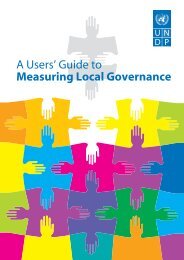English - UNDP
English - UNDP
English - UNDP
Create successful ePaper yourself
Turn your PDF publications into a flip-book with our unique Google optimized e-Paper software.
sustainable national development 2 . Following the PAR Strategy, a<br />
new public administration system for the country was adopted 3 ,<br />
and work on reorganizing public entities and institutions began.<br />
Country<br />
context<br />
A small, landlocked nation with a population of about 7.2 million,<br />
Tajikistan is one of the world’s least accessible countries. Its high,<br />
mountainous terrain and remoteness are compounded by a<br />
lack of infrastructure and a weak governance and regulatory<br />
framework. These are significant barriers to external trade,<br />
connectivity, and investment. It remains the poorest of the<br />
countries that emerged from the former Soviet Union and its<br />
fragile economy, still heavily reliant on agriculture, aluminium,<br />
and hydroelectric power – as well as on its neighbours, especially<br />
Uzbekistan, for international trade and transit – is vulnerable to<br />
unexpected shocks, such as the severe 2007-08 winter, the 2007<br />
upsurge in world food and fuel prices, and, more recently, the<br />
global economic crisis. Its post-independence five-year civil war<br />
(1992-97) resulted in significant economic and human losses<br />
amounting to an estimated 60 percent of GDP, and up to 50,000<br />
deaths, and greatly complicated its initial economic transition.<br />
Tajikistan is a presidential republic, with a bicameral legislature.<br />
The heavily centralized country is led by the President, Imomali<br />
Rahmon. The People’s Democratic Party of Tajikistan, led by the<br />
President, won the February 2010 general election with 71.04<br />
percent of the vote, and controls both houses. Real power<br />
is concentrated in the executive rather than the legislative<br />
branch of government. The role of civil society in politics, policy<br />
development, and decision-making processes remains weak.<br />
The public sector is also weak. Many public institutions are<br />
inefficient, lacking accountability and transparency in financial<br />
management and internal controls. The systems, procedures, and<br />
capacity to fight corruption are frail, and the legal and regulatory<br />
frameworks remain underdeveloped. The government has,<br />
though, attempted to deal with these deficiencies. In March<br />
2006, it adopted the Public Administration Reform Strategy<br />
of the Republic of Tajikistan 1 (2005-2015), whose goal was to<br />
develop an effective public administration system as a basis for<br />
Corruption remains one of the most serious problems for<br />
Tajikistan. One of the first steps taken to address the issue<br />
was the OECD’s Anti-Corruption Plan, adopted in Istanbul in<br />
2003 4 . The government developed the National Anti-Corruption<br />
Strategy, 2008 – 2012, as a nationwide anti-corruption plan. The<br />
State Committee on Financial Control and Fighting Corruption 5<br />
is responsible for implementing the anti-corruption measures.<br />
Socio-economic trends and developments<br />
Tajikistan’s macroeconomic performance has improved steadily<br />
in recent years. It has seen GDP grow at 8 percent annually,<br />
declining inflation, greater fiscal discipline, and a manageable<br />
external debt. Growth was fuelled mainly by high world prices<br />
for aluminium and cotton, Tajikistan’s principal exports, and by<br />
remittances. 6 The economy is gradually diversifying, and this is<br />
reflected, inter alia, in the much smaller share of aluminium and<br />
cotton in value added products 7 , and an increase in the output<br />
of non-traditional products. But Tajikistan remains the poorest<br />
of the former Soviet Union republics, with income per capita<br />
reaching just US$2,020 in 2010 8 . It has made progress in terms<br />
of enabling the business environment 9 , but efforts are still far<br />
below those of neighbouring countries 10 . Poverty has declined<br />
since 1999 (from 72.4 percent in 2003 to 46.7 percent in 2009 11 ),<br />
but still remains high. About 53 percent of the population,<br />
rising to 70 percent in isolated rural and mountainous areas,<br />
lives below the poverty line 12 .<br />
1<br />
Approved by Presidential Decree No. 1713 on 15 March 2006.<br />
2<br />
Specific objectives are to i) Increase effectiveness of the national development<br />
management: ii) Improve public administration in line with the market economy<br />
principles; iii) Increase effectiveness of the public finance management; iv) Form<br />
modern professional civil service; v) Develop administrative and territorial management;<br />
vi) Form local self-governance capable to provide qualitative services to<br />
the population.<br />
3<br />
Presidential Decree 541 (September 2008).<br />
4<br />
http://www.oecd.org/dataoecd/51/3/37228458.pdf Last access: 26 April<br />
2011. In particular, the Istanbul Action Plan of the ACN creates a peer review<br />
mechanism for a group of ex-Soviet countries. Tajikistan made its first status<br />
report to the group in January 2004, and remains committed to implement<br />
the resulting 21 recommendations.<br />
5<br />
Signed by the President on 24 January 2008.<br />
6<br />
Remittances rose from $82 million (5% of GDP) in 2003 to $2.6 billion (50%<br />
of GDP) in 2008.<br />
7<br />
10% in 2006 compared to 30% in 2000.<br />
8<br />
Compared for example with USD 2291 Kyrgyzstan and 3,084 Uzbekistan for<br />
more details ref. to: http://hdrstats.undp.org/images/explanations/TJK.pdf<br />
Last access: 26 April 2011.<br />
9<br />
World Bank’s Doing Business 2011 report showed improvement from 149 in<br />
2010 to 139 in 2011.<br />
10<br />
For example: Kazakhstan (59) and the Kyrgyz Republic (44).<br />
11<br />
MDG Progress Report.<br />
12<br />
Projections based on World Bank. 2008. Tajikistan Living Standards Measurement<br />
Survey, 2008. Washington, DC.<br />
11








![GuÃa del Usuario ] - Governance Assessment Portal](https://img.yumpu.com/44740603/1/190x253/gua-a-del-usuario-governance-assessment-portal.jpg?quality=85)








